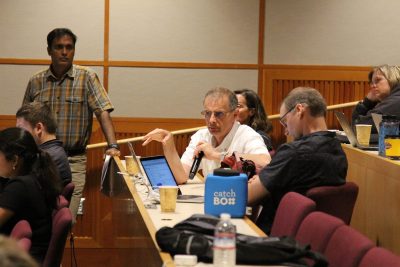Annual Developers Meeting Focuses on ARM Facility’s Future
Published: 7 September 2017

About 50 people gathered at Pacific Northwest National Laboratory (PNNL) in Richland, Washington, for the annual ARM Developers Meeting to discuss the past year’s efforts and chart a path for the upcoming year and beyond. ARM developers build and refine tools related to data flow, data discovery, and delivery, such as software, databases, and computer infrastructure.
The event, which took place July 18 to 19, drew participants from ARM’s External Data Center, Data Quality Office, Data Center, and Data Management Facility, as well as infrastructure management, operations staff, and scientists. Architecture and Services Strategy Team (ASST) Manager Giri Prakash, from Oak Ridge National Laboratory, helped keep the program running smoothly both days. The ASST, which oversees the representation of and communication with software development and operations team members, planned and led the meeting.
“ARM data services are a complex enterprise run by many moving parts,” Prakash says. “This meeting focused on streamlining and improving various processes that ARM infrastructure staff currently use to manage the end-to-end data life cycle. It is important to reassess our requirements and build tools and workflows using an adaptive architecture.”
Looking Back—and Ahead
ARM Technical Director Jim Mather, PNNL, welcomed the group by highlighting encouraging fiscal year 2018 budget numbers from Congress, facility updates, field campaigns, and instrument evolutions. He says he expects the ArcticShark, an unmanned aerial system that the ARM Facility took possession of earlier this year, to start helping with research next summer.
Mather also told the audience about the findings from the 2017 ARM triennial review, which took place in April. The U.S. Department of Energy selects the panel that performs the facility review every three years. Mather said the reviewers were positive, but thinking in new ways will be important for the ARM Facility looking ahead. “How do we do this best to make us more efficient to do other things?” he says.
The second day opened with presentations by ARM Chief Operating Officer Jimmy Voyles, who will retire September 30, and Nicki Hickmon, who will move into the new role of Associate Director for Operations on October 1. Voyles, PNNL, and Hickmon, Argonne National Laboratory, talked about the visions, challenges, and future of the ARM Facility.
Hickmon asked ARM staff for feedback on changes they would like to see within the ARM Facility. Staff also need to be flexible and adaptable, set priorities, and ask informed questions when new ideas or changes are suggested.
Voyles, who has worked in ARM for almost 23 years, emphasized that plans should be made with the understanding that the ARM Facility does not have an end date. Of ARM’s infancy, Voyles says, “We thought this was a 10-year program.”
Breakout Sessions and Action Items
Breakout sessions over the two days covered topics such as data tools for modeling, machine learning efforts across the ARM Facility, ARM Data Center resources, and cyber security. Some action items discussed in the sessions were:
- creating an official ARM definition of uncertainty and how to share it with users
- revisiting ARM data file standards in preparation for the next rollout
- finding core users who can promote the use of ARM tools and get feedback from them
- developing a three-year ARM Data Integrator Software vision document
- building a modular workflow that will remove unnecessary workflow processes and address multiple infrastructure needs
- identifying gaps in skills and potential options for upgrading skills and technologies.
ARM lead translator Laura Riihimaki, PNNL, presented action items that came out of the ARM Translator Planning Workshop in June. ARM User Executive Committee Chair Larry Berg, PNNL, provided updates from his group, which communicates with ARM Facility leadership about the user experience.
ARM modeler Bill Gustafson, PNNL, covered the status of the large-eddy simulation (LES) project known as LASSO—LES ARM Symbiotic Simulation and Observation, for which he is the principal investigator. Gustafson says LASSO is in a “soft transition” period as it moves to full operations following a two-year pilot phase. A transition plan and recommendations are due to the U.S. Department of Energy on November 30.
If you were unable to attend the meeting, check out some photos.
The ARM Climate Research Facility is a DOE Office of Science user facility. The ARM Facility is operated by nine DOE national laboratories.
Keep up with the Atmospheric Observer
Updates on ARM news, events, and opportunities delivered to your inbox
ARM User Profile
ARM welcomes users from all institutions and nations. A free ARM user account is needed to access ARM data.


















